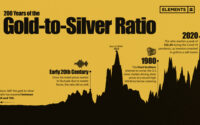Swiss Metal Detectorist Finds 1,290 4th Century Roman Coins!
Nearly 1,300 priceless 4th-century AD Roman coins, all in a pot, were found in September 2021 near Bubendorf, Basel County, Switzerland by amateur archaeologist volunteer, Daniel Ludin. During one of Daniel’s metal detector searches in a forest at Wildenstein Castle, the alert went off. Digging down he just found a few coins and potsherds, but the detector kept buzzing. Digging further he discovered the Roman coin hoard in what was once a really big pot, according to the report in Archaeology Baselland.
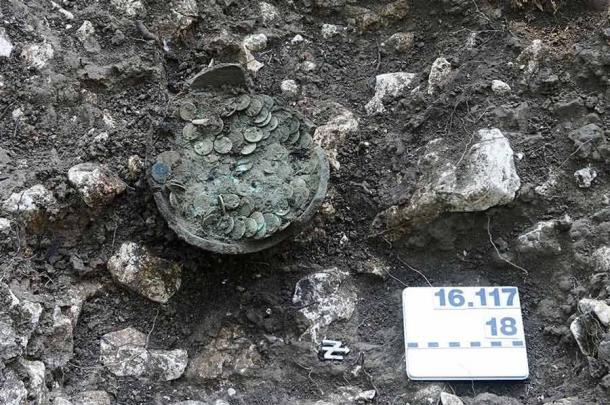
The ceramic pot with the coins during professional excavation by employees of Archaeology Baselland. ( Archaeology Baselland )
Rare Hoard of Roman Coins Dated to the Constantine Era
A big broken pot overflowing with copper coins was the Swiss amateur archaeologist’s eventual jackpot find. The entire hoard of Roman coins dated to Emperor Constantine’s reign (306-337 AD). They were the equivalent of a gold solidus, which is 2 months’ salary for a Roman Legion soldier. The youngest coins in the hoard dated to 332-335 AD.
Coin hoards from a time of economic stability are unusual. And that’s what makes this hoard both rare and unusual. Comparatively, Constantine’s reign was marked by overall peace and tranquility, Therefore, coin hoards from this Roman period are rare.
Conversely, in times of economic instability, people would bury coins and currency in the hope of using them in better times and to protect them. Instability would include civil wars, incursions by neighboring ethnic groups, and economic crises .
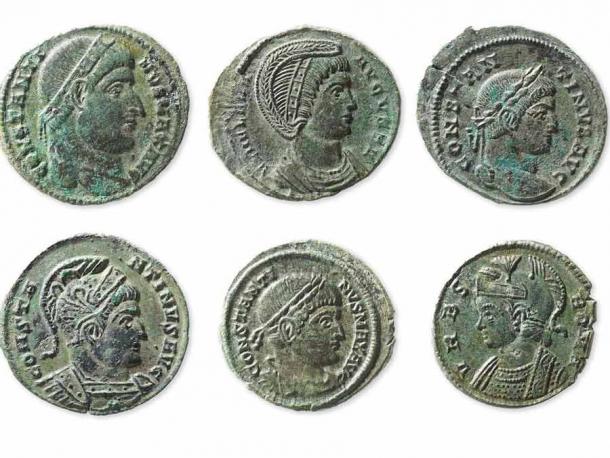
All the Roman coins in the recent Swiss Roman coin hoard, made during the reign of Constantine the Great (306-337 AD), show portraits of the emperor and his relatives in the front. (Rahel C. Ackermann / Inventar der Fundmunzen Schweiz )
The September 2021 Swiss Roman coin hoard burial find indicates either a religious offering to the gods, or a peace offering (the site was on a border shared by three Roman estates ), or perhaps a boundary line sacrifice. The reasons for this are still not entirely clear, particularly because the exact years matching this coin hoard were characterized by their political stability and minor economic recovery, and there are hardly any contemporaneous hoards from this era in the Roman Empire’s history .
Part of the many reforms enacted by Constantine include the separation of civil and military authorities, and the introduction of the gold solidus coins . The gold coins, meant to combat the crippling inflation of the 3rd century AD, replaced the pure silver argentus coins in 305. The gold solidus would become the standard for Byzantine and European currencies for more than 1,000 years. Constantine also shifted the capital of the Roman empire to Byzantium, renaming it Constantinople (modern-day Istanbul).
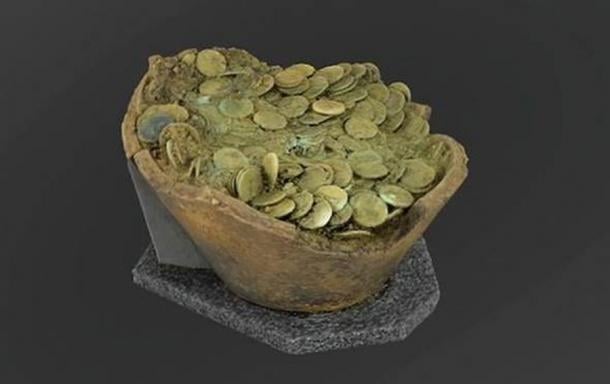
A 3D model of the jar of ancient Roman coins which was found by an amateur archaeologist in Switzerland in September 2021. (Jan von Wartburg / Archaeologie Baselland )
An Amateur Archaeologist with A Deep Sense of Professionalism
Daniel Ludin was extremely cautious about his find. He left the loot, filled in the hole, and immediately informed Archeologie Basselland, which allowed them to preserve the pot in a soil block with coins, pot fragments, and invisible archaeo-organic remains excavated under laboratory conditions. This allowed for a CT scan of the soil block, indicating a separation of the coins in the pot into two parts by a piece of cowhide, the reason and purpose of this remains unclear.
Says Andreas Fischer of Archaeologie Baselland, “One can only speculate about the meaning and purpose of this separation.” Since September 2021, when the discovery was originally made, the finds were carefully transferred to the Swiss Federal Laboratories for Materials Testing and Research (EMPA) in Duebendorf. Here computer tomography (CT) scanning, and a powerful X-ray have been employed to figure out what’s what.
In a statement obtained by Zenger News , Fischer added that, “After recovering several Roman coins and fragments of pottery, the full extent of his discovery became apparent: a hoard of coins that had been buried in a pot came to light. Daniel Ludin acted very carefully. He covered the find again and informed Archeologie Baselland. Thanks to this professional approach, an excavation team from Archäologie Baselland was able to salvage the pot in one piece.”
Despite the observations regarding the relative peace and stability of the Constantine era made by the current archaeology team, there was an important point of observation that one must note. Bronze coins, over time, continued to be devalued in favor of the silver and gold currency, creating gold as the fiduciary standard. This, in time, created a class divide between the wealthy and the poor, with the latter holding on to the bronze currency, while the rich benefited from the stability of the gold coinage.
Top image: Archaeologist from Archaeology Baselland excavates the pot of Roman coins. Source: Archaeology Baselland
By Sahir Pandey
[ad_2]
Source link
Related Posts
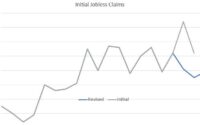
Initial Jobless Claims Rise After Massachusetts Fraud Revisions
Today’s top gold news and opinion
